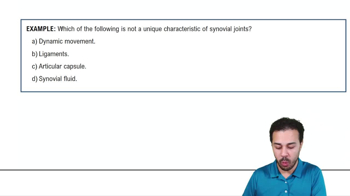Mark the following statements as true or false. If a statement is false, correct it to make a true statement.
a. The knee and the elbow are multiaxial joints.
 Verified step by step guidance
Verified step by step guidance



Mark the following statements as true or false. If a statement is false, correct it to make a true statement.
a. The knee and the elbow are multiaxial joints.
Mark the following statements as true or false. If a statement is false, correct it to make a true statement.
b. The elbow joint consists of two separate articulations.
Which factors contribute to the stability of the hip joint?
Identify each of the following joints as synovial, fibrous, or cartilaginous.
a. Pubic symphysis______
b. Elbow joint_____
c. Epiphyseal plate_______
d. Frontal suture_________
e. Gomphosis___________
When articular cartilage is damaged, often fibrocartilage forms instead of new hyaline cartilage. Does fibrocartilage have the same properties as hyaline cartilage? Is it likely to provide the same type of surface as hyaline cartilage? Explain. (Connects to Chapter 4)
Mark the following statements as true or false. If a statement is false, correct it to make a true statement.
a. Fibrous joints are united by collagen fibers.